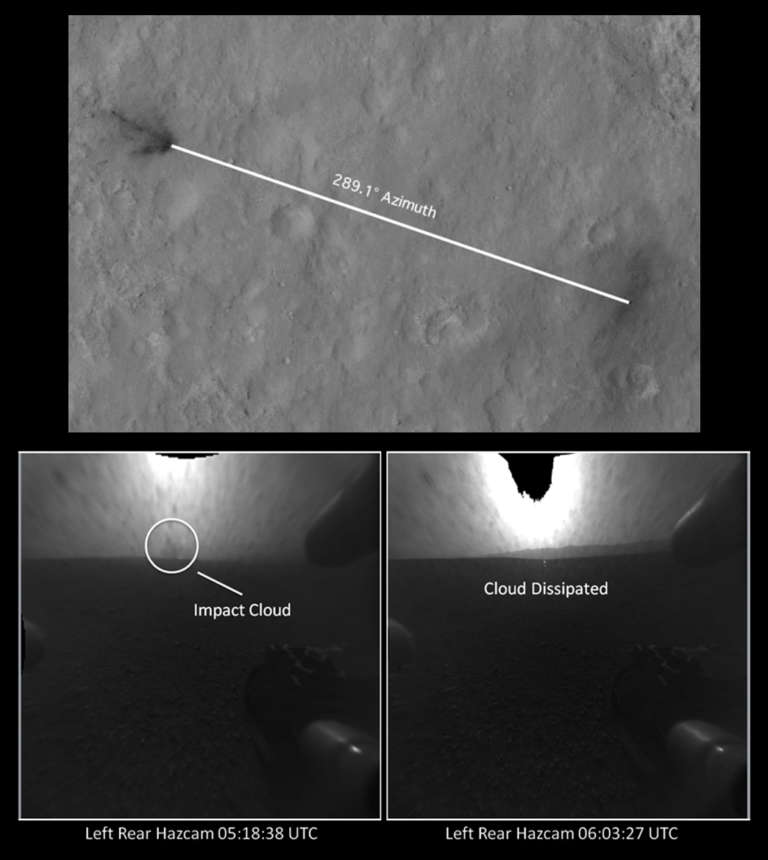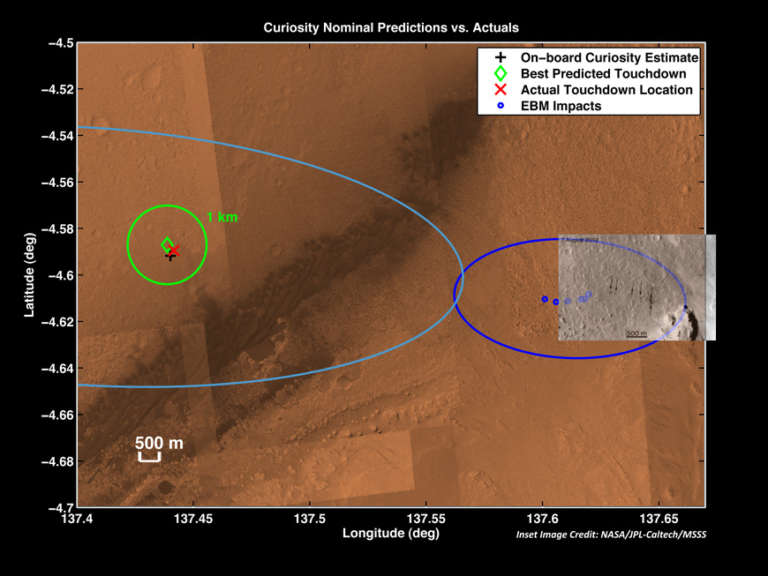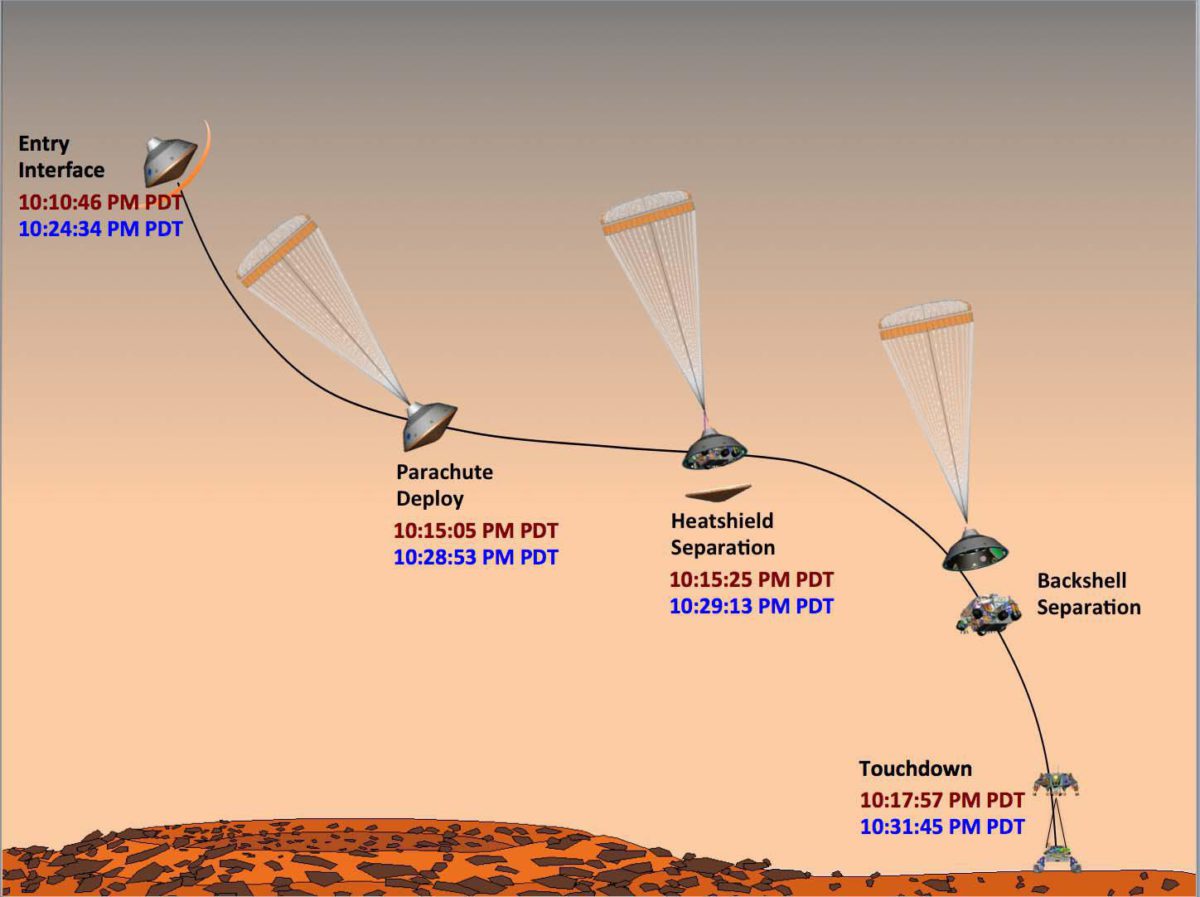Jason Davis • Aug 10, 2012
Curiosity sol 4: EDL updates, rover ready for software upgrade
Today marked the final Curiosity press conference of the week. It didn't bring us anything new in terms of striking images from the surface, but we received a lot of updates from the now-legendary entry, descent and landing (EDL) team that safely deposited the rover on Mars. It was also confirmed that the puff of dust seen by Curiosity's rear Hazard-avoidance cameras shortly after landing was likely the descent stage impacting the Martian surface at around 160 kilometers per hour. Finally, Curiosity's chief software engineer walked us through the next four upcoming sols, in which the rover's flight software will be upgraded to version R10.

We'll start with EDL news. If you're in a hurry, I can save you from reading the next few paragraphs by reiterating what we already knew: the landing was near-perfect. It was so perfect, in fact, that it puts the EDL team in the awkward position of having to explain why they landed a mere two-and-a-half kilometers from their target, narrowly missing a bulls-eye. The reason for that slight miss, according to guidance engineer Gavin Mendeck, may have been a final bank reversal the backshell was executing shortly before the supersonic parachute was deployed. Those bank reversals were course corrections the rover made as it plummeted through the martian atmosphere.
Here's a handful of other EDL facts that were kicked around during the press conference, further showing us just how nominal the landing was:
- Curiosity hit the atmosphere only about a kilometer and a half from its intended target.
- The parachute was scheduled to deploy between 241 and 263 seconds after entry interface. It deployed at 259 seconds.
- The wrist mode, or wobble, of Curiosity under parachute was "very benign," according to engineer David Kipp.
- The rate of rotation under parachute varied around one to two degrees per second, which was lower than anticipated. During the MARDI thumbnail video, the rover makes a full rotation.
- Curiosity's heat shield was ideally supposed to be fifteen meters away within five seconds upon release, giving the radar a good view of the landing site. It cleared that distance in just three seconds.
- Trajectory specialist Jody Davis said Curiosity was able to lock onto the landing site a kilometer and a half higher than expected.
- The team now has official times for all major EDL events: the seven minutes of terror officially began with entry interface at 10:10:46 PM PDT, ending with touchdown at 10:17:57 PM PDT.


For the next four sols, virtually no science will take place while Curiosity's flight software is upgraded to version R10. Chief software engineer Ben Cichy said that if the new software had a marketing tag line, it would be "optimized for surface." R10 contains everything the rover needs to drive, avoid obstacles, use its robotic arm and process samples.
Why not leave home with the software already in place? This is best answered starting with a quick review of Curiosity's computer system. The rover has two redundant computers, each containing a 200 MHz processor and 4GB of storage. You hardly need to be an IT expert to know that isn't very much. Cichy held up his iPhone during the press conference as a point of comparison; the lowest-end current version has an 800 MHz processor and a 16GB hard drive.
Cichy's iPhone, however, is not designed to withstand the forces of launch atop an Atlas V rocket, nor must it handle 11 Gs resulting from atmospheric entry. It isn't radiation-hardened for eight months of interplanetary travel, or insulated for the harsh subzero temperatures of the Martian surface. Furthermore, Curiosity's design was finalized years ago, long before the current versions of smartphones were available.
As it is, Curiosity has a finite amount of storage and processing power for its flight software. Therefore, as the mission progresses, engineers must delete some "apps" (to continue the iPhone analogy) after they are no longer needed and install different ones. Curiosity launched with software version R9.3, which, according to Cichy, had four apps: launch/cruise, EDL, surface operations and software updates. During the first week of June while the rover was quietly travelling to Mars, engineers installed version R9.4. With that upgrade, the launch/cruise app became just a cruise app, while EDL and surface operations were replaced with newer versions. Later, software version R10 was uploaded to the rover's file system, but not installed. Now that Curiosity is safely on the ground, it can ditch its cruise and EDL apps.
How does one update a rover's flight software? If you've ever booted your computer from a CD or flash drive (or, back in the day, a floppy disc), you've experienced a taste of how the upgrade process works. Engineers will first boot the rover's primary computer into version R10 without actually installing it, allowing them to test it. This is similar to how many versions of Linux will run entirely in your computer's memory -- off of that aforementioned CD or flash drive -- without requiring you to install the operating system to your hard drive.
The complete upgrade process will go something like this:
- Sol 5: boot prime computer into software version R10, perform diagnostics
- Sol 6: upgrade prime computer to software version R10
- Sol 7: boot secondary computer into software version R10, perform diagnostics
- Sol 8: upgrade secondary computer to software version R10
So, if all goes well, early next week for sol 9, Curiosity will be running on flight software version R10, ready for science!


 Explore Worlds
Explore Worlds Find Life
Find Life Defend Earth
Defend Earth

